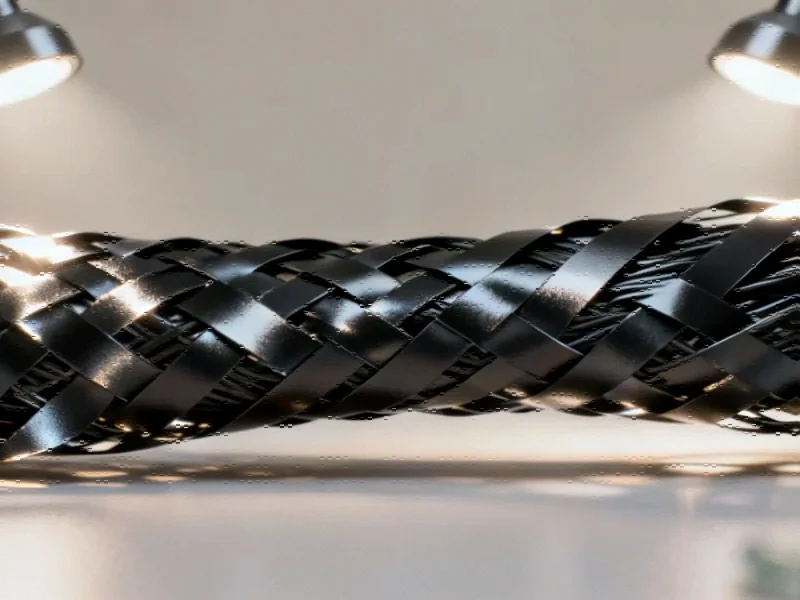The Energy-Intensive Legacy of Carbon Fiber Production
For decades, the exceptional properties of carbon fiber have come with an enormous energy cost. Traditional manufacturing requires temperatures exceeding 1,300°C to transform organic precursors into the graphene-based structures that give carbon fiber its remarkable strength-to-weight ratio. This high-temperature carbonization process consumes approximately 17 times more energy than steel production and accounts for nearly 40% of total manufacturing costs. The industrial sector has long sought alternatives to this energy-intensive approach, but conventional wisdom suggested that high performance necessitated high temperatures.
Breakthrough in Room-Temperature Manufacturing
Researchers have now demonstrated that exceptional carbon fiber properties can be achieved without extreme heat through a novel domain-folding strategy. This approach directly assembles graphene structural units at room temperature, bypassing the traditional carbonization pathway entirely. The resulting graphene fibers achieve an average tensile strength of 5.19 GPa and Young’s modulus of 529 GPa – performance parameters that rival or exceed traditionally manufactured carbon fibers despite the dramatically reduced energy requirements.
This manufacturing breakthrough represents a significant departure from previous attempts at low-temperature production. Earlier graphene fiber efforts still relied on high-temperature treatments to enhance mechanical properties, with some processes requiring annealing at 2,500°C to achieve strengths around 3.4 GPa. The domain-folding method eliminates this thermal dependency while simultaneously improving performance. For those interested in the technical details of this manufacturing revolution, recent analysis of room-temperature manufacturing methods provides comprehensive coverage of the underlying science.
Overcoming Assembly Defects Through Structural Innovation
The key innovation lies in addressing the fundamental challenge of graphene assembly: defect formation. Traditional wet-spinning of graphene oxide produces microvoids, wrinkles, and structural imperfections that severely limit mechanical performance. The domain-folding strategy minimizes these defects by controlling the assembly process at the molecular level, enabling superior stress transfer throughout the fiber structure.
This approach to minimizing manufacturing defects parallels recent developments in industrial computing infrastructure, where addressing systemic weaknesses has led to significant performance improvements. In both cases, identifying and resolving fundamental structural limitations has enabled breakthrough capabilities.
Superior Functional Properties Beyond Mechanical Performance
The room-temperature graphene fibers exhibit exceptional functional characteristics that extend beyond their mechanical properties. Thermal conductivity measurements reveal values of 232 W/mK – approximately 625% higher than conventional polyacrylonitrile-based carbon fibers, which typically measure below 32 W/mK. This combination of high strength and excellent thermal management suggests numerous applications in advanced electronics and thermal management systems.
These material advances coincide with broader technological breakthroughs across multiple industries that are redefining performance standards. The convergence of materials science, manufacturing technology, and computational design is creating unprecedented opportunities for innovation.
Industrial Applications and Market Implications
The implications for industrial applications are substantial. The dramatic reduction in energy consumption makes high-performance carbon fibers more accessible for:
- Automotive and aerospace components
- Advanced energy storage systems
- Next-generation wind turbine blades
- Thermal management in high-power electronics
- Structural elements in portable devices
This manufacturing innovation arrives during a period of significant market transformation across multiple technology sectors. The ability to produce high-performance materials with reduced energy input creates new competitive dynamics and supply chain opportunities.
The Future of Advanced Materials Manufacturing
This breakthrough demonstrates that moving beyond conventional manufacturing paradigms can yield simultaneous improvements in performance, cost, and sustainability. The success of room-temperature graphene fiber production suggests that similar approaches might be applicable to other advanced materials, potentially revolutionizing multiple industrial sectors.
The development of these advanced manufacturing techniques reflects broader scientific revolutions occurring across research domains. As computational modeling and material science continue to advance, we can expect further disruptions in traditional manufacturing approaches.
These manufacturing innovations are part of a larger pattern of strategic technological pivots across multiple industries, where fundamental reassessments of established processes are yielding remarkable results. Similarly, the materials science community is witnessing important lessons about technological implementation that apply equally to advanced manufacturing and computational systems.
The room-temperature production of high-performance graphene fibers represents more than just an incremental improvement – it signals a fundamental shift in how we conceptualize material manufacturing. By directly assembling structural units rather than transforming precursors through energy-intensive processes, researchers have opened a new pathway to advanced materials that combines exceptional performance with dramatically reduced environmental impact.
This article aggregates information from publicly available sources. All trademarks and copyrights belong to their respective owners.
Note: Featured image is for illustrative purposes only and does not represent any specific product, service, or entity mentioned in this article.



